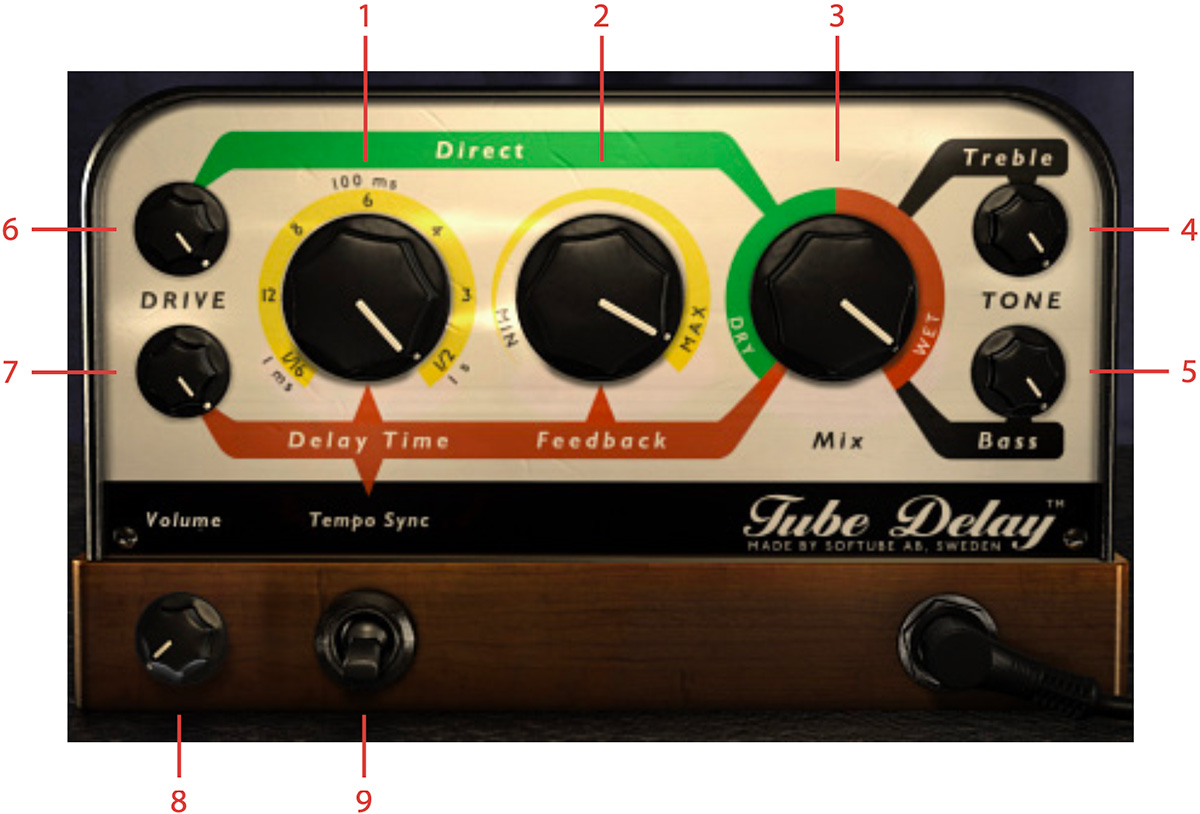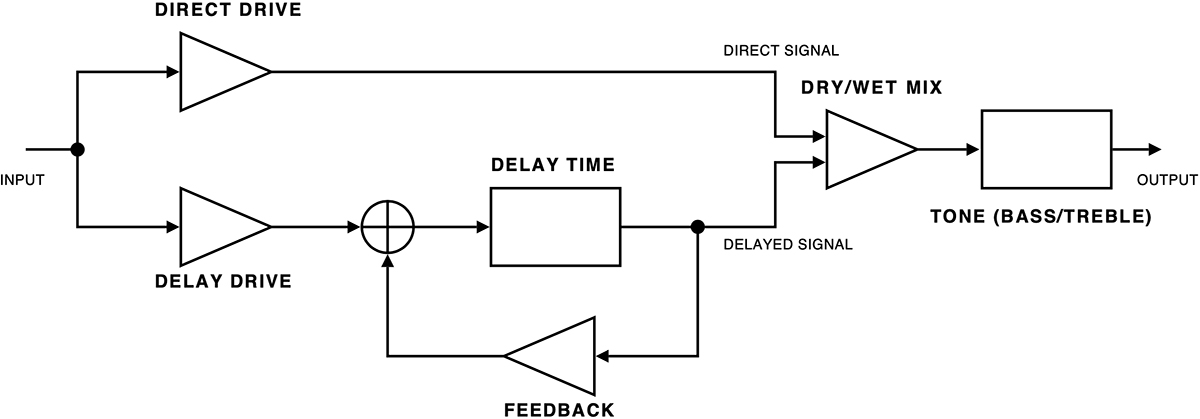The delay audio effect has a long history going back to the times when recording engineers would experiment with analog tape to get a decaying echo effect. Later on, standalone tape delay units were built and even later, delay created with digital technology became possible. Vacuum tubes, or valves, used in audio equipment are known for their unique sonic imprint on sound, something we perceive as “warmth” when the signal passing through it is overdriven.
Tube Delay is a marriage between analog and digital, combining the warmth and natural compression from tubes with the features and versatility of a digital delay. There are three tube sections in Tube Delay, one in the direct signal section, one in the delay feedback loop and one after the feedback loop. The tube sections are created with Softube’s patented modeling technology and gives a faithfully recreated sound of a “real” tube preamp.
So, think of Tube Delay as a tube preamp with an added delay section. The tubes in the delay section deteriorates the signal and you can even add more distortion after the delay before blending it with the direct signal passing through the preamp. The effect is perfect for fattening vocal tracks, adding slapback echo to drums or getting a gritty delay for guitars!

Click here to view the full-sized image in a new tab
- Delay time
- Feedback
- Dry/Wet mix
- Treble
- Bass
- Direct (Dry) drive
- Delay (Wet) drive
- Output volume
- Tempo sync
Mix: Controls the balance between the delay and the direct signal. Outputs only the original signal through the tube preamp section when set on DRY, and only the delay effect with added tube saturation when set to WET.
Set this control to blend the wanted amount of delay with the dry signal.
Remember! Since there are drive controls for both wet and dry signal paths that affects the volume, you might need to readjust the Mix after changing the Drive controls.
Direct Drive (top knob): Controls the amount of tube drive in the dry signal path. Because the dry signal path is really a model of a tube preamp, you can use the dry signal path to color or distort audio passing through it like you might use a “real” tube preamp.
Try moving the Mix control to full left and notice the coloring of the dry signal path when adjusting Direct Drive. This can be useful to just add some warmth to a single track or even a whole mix.
Delay Drive (bottom knob): Controls the amount of tube drive in the wet signal path. Use Delay Drive to add color or distortion to the delay signal. This can make the delay signal stand out in a mix and give it a sound that ranges from organic to smashed.
Delay Drive affects the signal after the delay line feedback loop and will thus add distortion to all repetitions of the delay.
Delay Time and Tempo Sync: Controls the length of the delay in milliseconds or syncs to host tempo. The total length of delay after the original signal in Tube Delay is one second. In millisecond mode (Tempo Sync OFF ), Delay Time will adjust the time from 1 to 1000 ms. The first half of the control goes from 1 to 100 ms, the second half goes from 101 to 1000 ms. This gives tweaking in the 1 to 100 ms range a greater resolution.
Common Delay Time settings are around 40 ms for a doubling effect and roughly 100 to 250 ms for a slapback echo.
When the Tempo Sync switch is ON (the “up” position), Delay Time is synced to the tempo setting of the host application. The Delay Time knob sets the length of the delay in these fractions of a measure: 1/16, 1/12, 1/8, 1/6, 1/4, 1/3 and 1/2.The maximum delay time is still one second though. To get to these values directly, simply click the numbers around the knob. It’s also possible to get values in between the fractions by adjusting the knob.
Some hosts don’t support reporting Tempo information to the plugin, in these cases a warning will be displayed.
Tempo Sync: Here are some examples of the resulting delay time for a given host tempo when the Tempo Sync switch is set to ON (upwards position).

1/12 is the equivalent of an eighth note triplet. 1/6 is a quarter note triplet (a common reggae/dub delay rhythm). 1/3 is a half-note triplet.
Feedback: Controls the amount of delay repetitions. The higher this setting is, the higher the amount of delay is returned to the input of the delay line.
Feedback goes from no repetitions (just a single delay) to a full feedback with never-ending repetitions.
Tone Settings - Bass and Treble: Controls equalization of the input of the effect. This affects both dry and wet signal paths and thus also the amount of distortion.
Output Volume: Set the level of the output of the plug-in.
Block diagram of the Tube Delay effect. As you can see, the dry signal (direct signal) isn’t very dry, it is affected by both the tone stack and the tube circuits in the Direct Drive knob.
For simplicity, the Tone control has been depicted as the last stage after the Mix knob. In reality, the Tone control is embedded within all tube stages, and will thus affect all distortion.

Click here to view the full-sized image in a new tab
A whole range of added control can be accessed with Extended Features. Please see the separate "Extended Features" manual for more information.
Torsten Gatu – Sound design and framework programming
Oscar Öberg – Modeling and framework programming
Niklas Odelholm – Framework programming and graphic design
Arvid Rosén – Framework programming
Ulf Ekelöf – 3D rendering and graphics
Henrik Midtgaard – Concept